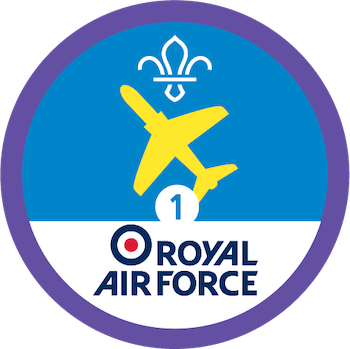
Ground control games
You’ll need
- String
- Paddles, torches or glowsticks (optional)
- Hi vis jackets (optional)
Before you begin
- This activity contains a number of games to help everyone practise their air marshalling signs. The activity is best run in the order set out below.
- Speak to anyone with knowledge of aircraft marshalling duties working towards their Air Activities Staged Activity Badge before the session. See if they’d be happy to help run some of the games in this session. This could be one person or several.
- Leaders and helpers should familiarise themselves with the role of air marshallers using the information on this page and by researching International Civil Aviation Organisation (ICAO) signals, if they wish to lead the games in this activity.
- Aircraft marshallers are people responsible for guiding aircraft through small gaps or into parking spaces on an airfield, known as ‘stands’.
- Marshalling is a set of arm movements that allow workers on the ground to communicate with a pilot without having to talk to them, although a radio can also be used for detailed instructions.
- Standard signals are used by marshallers on airfields all over the world. These are set by the International Civil Aviation Organisation (ICAO).
Run the activity
- Start by running a mirroring game. Everyone should stand together. Those with knowledge of aircraft marshalling signals, who’ve agreed to run this game, should step forward. This might be helpers, leaders or young people.
- Explain that the person or people leading the game will demonstrate some of the signals marshallers use to guide aircraft on the ground.
- Demonstrate some common marshalling signals and have everyone copy them. If you’ve got lots of people who know this already, just do a quick recap. If lots of your group are new to marshalling signals, spend 10 minutes or more demonstrating and practising.
- Once everyone’s familiar with all the basic signals, run an alphabet game. Make sure you still have enough experts to support anyone new to marshalling signals, and to lead this next game as interpreters.
- Have two volunteers with good knowledge step forward and number them ‘one’ and ‘two’. Have everyone else line up on one side of the activity area. Tell these people that each of them is an aircraft. Tell the two volunteers that they are air marshals.
- The person leading the activity should secretly tell Marshal One a letter, number or shape. This should be something easily recognisable. Marshal Two should stand opposite the rest of the group (the aircraft). Tell them that they must identify the letter, number or shape that the aircraft will be formed into.
- Marshal One should now use signals to direct the rest of the group into their positions to form the letter number or shape. No-one should speak. The letter, number or shape should be formed in bird’s-eye view. When this has been done, Marshal One should give the ‘all clear’ signal and all of the aircraft should sit down.
- Marshal Two should try to guess the letter, number or shape. They might need to stand on a step to do this. A helper should remain close at hand if this is the case.
- The marshallers should swap roles and repeat the game with a different letter, number or shape.
Reflection
Ground control signals are set by an international organisation. Why do you think this is, and why might that make them useful for pilots landing in countries where they don’t speak the language? Can you think of any other ways we communicate using signals?
Clear signals were important to get the fleet in order. If you were new to aircraft marshalling signals, how many were you able to remember from the demonstration at the beginning? Did it help remind you when everyone else in the fleet moved into position? As with most new things, signals are easier learned as part of a team.
Safety
All activities must be safely managed. You must complete a thorough risk assessment and take appropriate steps to reduce risk. Use the safety checklist to help you plan and risk assess your activity. Always get approval for the activity, and have suitable supervision and an InTouch process.
- Active games
The game area should be free of hazards. Explain the rules of the game clearly and have a clear way to communicate that the game must stop when needed. Take a look at our guidance on running active games safely.
The games can be adapted to change the difficulty. Consider introducing a time limit or limiting words that are used. Marshalling signals could always be accompanied by ‘radio’ commands out loud to make things easier.
Anyone with limited mobility may need to use an alternative signal for a certain action, so make sure everyone is aware of what the alternative signal will look like.
All Scout activities should be inclusive and accessible.
The group might benefit from and enjoy a visit to a local airfield, flying show or even a flying club, so they can see some of the moves in action. Leaders should take a look at ‘Access to Airfields’ guidance available here.
For more information about air activities and how you can take part, check out the Scouts activities
Many of those who took part in this activity had the opportunity to demonstrate their knowledge, guide their peers and teach them something new.
